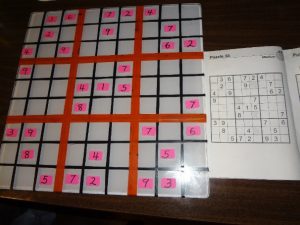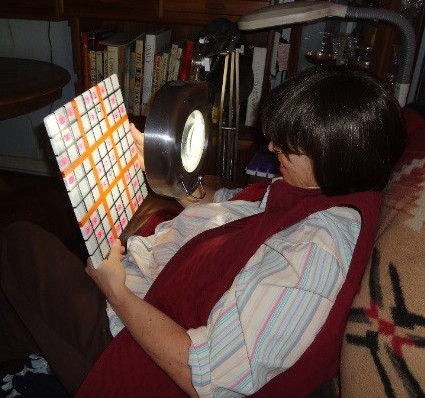Katheryn Stubsten is not about to give up her hobbies just because she has macular degeneration; instead, she frequently visits MonTECH’s lab to try equipment that might compensate for her diminishing sight. Describing her vision, she says, “I can still see little bits here and there. It’s really difficult to read. Everything looks snowy.” By way of explanation, she adds, “Remember back in the old days, if you didn’t have your TV quite tuned in, it looked snowy? That’s what I see.”
As an avid reader, Katheryn works to find apps and equipment that will enable her to continue to enjoy reading. Unfortunately, finding a way to work her Sudoku puzzles has been trickier. With her low vision, Katheryn had to give them up; that is, until her husband Will came up with a solution.
Will Stubsten is a pro-active problem-solver. “Seems like we have been able to overcome many obstacles as her eyesight has deteriorated,” he explained. “The Sudoku puzzle was one of those.”
 Will makes Katheryn’s puzzles out of Plexiglas®. The Plexiglas is covered on each side with protective covers. Will removes the cover from one side, but not the other. This produces a reflective effect. Combined with the remaining white protective cover, light is intensified and reflected back. (People with macular degeneration gradually require more illumination and greater contrast. More information on lighting and macular degeneration.)
Will makes Katheryn’s puzzles out of Plexiglas®. The Plexiglas is covered on each side with protective covers. Will removes the cover from one side, but not the other. This produces a reflective effect. Combined with the remaining white protective cover, light is intensified and reflected back. (People with macular degeneration gradually require more illumination and greater contrast. More information on lighting and macular degeneration.)
Will divides the Plexiglas into 81 squares (nine across, nine down) and marks them off with black electricians tape. He identifies the nine larger squares required for a Sudoku template with orange electrician’s tape.
Using a puzzle book, Will sets up each puzzle for Katheryn. Initially, he used dry-erase markers to write the provided numbers on the board, but in the course of her work, Katheryn would accidentally rub out numbers. His solution was to use sticker price tags, left over from a garage sale, and write the provided numbers on those tags. Katheryn can now work the puzzle without losing her provided clues. “It works,” Will said. “And now she solves these puzzles faster than I can set them up.”

